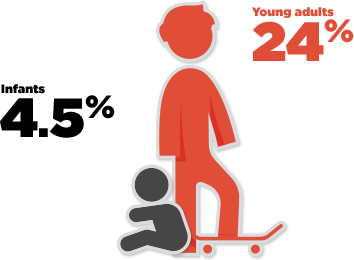KNOW THE FACTS
Common transmission behaviors


Meningitis B is contracted through contact with someone's saliva. This leaves teens and young adults at increased risk through common behaviors like kissing, close-quarter living, and sharing beverages and cosmetics.1,2
Regarding inequities and
mistrust in healthcare
There’s a long history of inequities that have broken the trust between black communities and healthcare systems. Even now, only 12% of black parents know about MenB vaccines, compared to 60% of white parents.*3 But we know absolutely that vaccines save lives. And we want everyone to understand the urgency of vaccinating their child against meningitis B—which is rare but can lead to serious illness, and in some cases even death, within 24 hours after the onset of symptoms.4,5
*Survey of parents and guardians, corresponding to 26,266,700 members of the US population (after weighting).3
let's look at the numbers

Some people are carriers of the bacteria that cause meningococcal disease, and show no symptoms, but can still potentially spread the disease to others. The disease is unpredictable, and no one really knows why some carriers become sick while others do not.6

Approximately 1 in 10 of those who develop MenB will die from it.8

MenB can kill within 24 hours.4

In adolescents and young adults, the incidence of MenB peaks at age 19, so people between ages 16 and 23 may be at higher risk.7

Up to 1 in 5 MenB survivors will have significant long-term or permanent consequences.9
Learn about a vaccine
that can help protect
against MenB

Some people are carriers of the bacteria that cause meningococcal disease, and show no symptoms, but can still potentially spread the disease to others. The disease is unpredictable, and no one really knows why some carriers become sick while others do not.6

In adolescents and young adults, the incidence of meningitis B (MenB) peaks at age 19, so people between ages 16 and 23 may be at higher risk.7

Approximately 1 in 10 of those who develop MenB will die from it.8

Up to 1 in 5 MenB survivors will have significant long-term or permanent consequences.9

MenB can kill within 24 hours.4
Learn about a vaccine
that can help protect
against MenB
References
- 1. Meningococcal disease. Centers for Disease Control and Prevention. Updated February 7, 2022. Accessed February 24, 2022. http://www.cdc.gov/meningococcal/index.html
- 2. Frequently asked questions about meningitis and the cases at Providence College, February 5, 2015. Providence College. Published February 5, 2015. Accessed February 24, 2022. https://health-center.providence.edu/files/2018/02/health-faqs.pdf
-
3. Srivastava A, Dempsey A, Galitsky A, et al. Parental awareness and utilization of meningococcal serogroup B vaccines in the United States.
BMC Public Health. 2020;20(1):1109.doi:10.1186/s12889-020-09181-8 -
4. Thompson MJ, Ninis N, Perera R, et al. Clinical recognition of meningococcal disease in children and adolescents. Lancet.
2006;367(9508):397-403 . -
5. Soeters HM, McNamara LA, Whaley M, et al. Serogroup B meningococcal disease outbreak and carriage evaluation at a college—Rhode Island, 2015. MMWR Morb Mortal Wkly Rep.
2015;64(22):606-607. -
6. Christensen H, May M, Bowen L, et al. Meningococcal carriage by age: a systematic review and meta-analysis. Lancet Infect Dis. 2010;10(12):853-861.
doi:10.1016/S1473-3099(10)70251-6 -
7. National Foundation for Infectious Diseases.
Addressing the Challenges of Serogroup B Meningococcal Disease Outbreaks on Campuses: A Report by the National Foundation for Infectious
Diseases . National Foundation for Infectious Diseases; 2014. Accessed February 24, 2022. https://www.nfid.org/publications/addressing-the-challenges-of-serogroup-b-meningococcal-disease-outbreaks-on-campuses-may-2014/ -
8. Cohn AC, MacNeil JR, Harrison LH, et al. Changes in Neisseria meningitidis disease epidemiology in the United States, 1998-2007: implications for prevention of meningococcal disease. Clin Infect Dis.
2010;50(2):184-191. -
9. Bettinger JA, Scheifele DW, Le Saux N, et al. The disease burden of invasive meningococcal serogroup B disease in Canada. Pediatr Infect Dis J.
2013;32(1):e20-e25.

